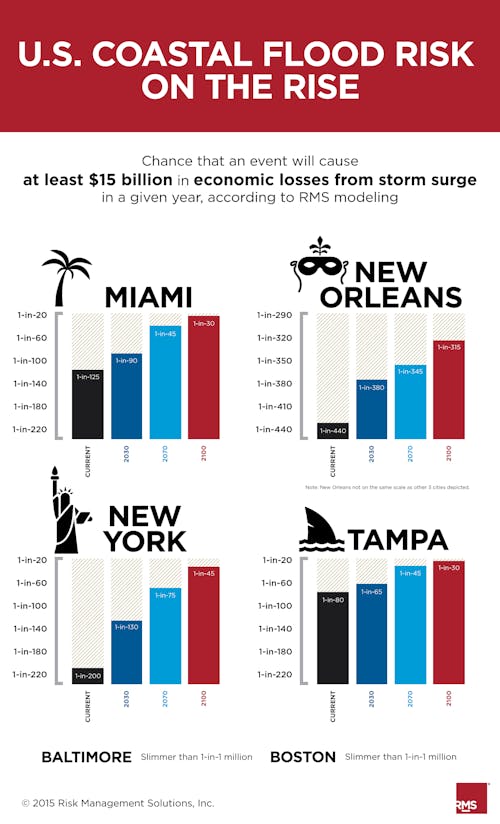In the ten years since Hurricane Katrina, New Orleans has done more to guard itself from the ocean than any other city in the nation. Thanks to state and federal funds totaling $14.5 billion, the city now has 133 miles of levees, floodwalls, and gates that can now withstand a 100-year flood. Officials have created more thorough evacuation procedures, while state and federal programs have helped residents adapt and elevate their homes for flooding.
Katrina, which killed 1,833, displaced more than 400,000 others, and caused $135 billion in damage, exposed New Orleans' vulnerabilities as a low-lying city. But the hurricane also proved something more broadly about storm preparation in America: We often underestimate the threat of coastal flooding and overestimate our ability to withstand it. And it's why we're just as unprepared to handle a Katrina-sized natural disaster somewhere else.
One general rule of thumb for determining how ill-prepared a city is for a hurricane is to look at the last time it was hit by a big one. Policies and local residents grow more relaxed as memory begins to fade, making long-term planning for 100-year or 500-year storms a challenge. “If you haven’t had a flood or hurricane in recent years you’re going to tune out and say it’s not going to happen to me,” said University of Pennsylvania Wharton School’s Howard Kunreuther, who is co-director of the school's Risk Management and Decision Processes Center. “When it occurs you say you’re going to do something.”
That’s what makes Tampa a top concern for scientists like MIT's Kerry Emanuel, who studies hurricanes. Tampa hasn’t been directly hit by a strong hurricane since the 1920s, though there have been a number of near-misses. Six died from the 1921 hurricane, when the population was a fraction of the four million people living in the surrounding area today. Emanuel cited western Florida and the northeast coast as parts of the country that “by sheer luck haven’t had storms in a long time.” These cities remain as vulnerable as ever. “The risk is probably in the next 50 years or so there will be a major hurricane in the region,” Emanuel said.

Tampa also recently topped the list of a report from RMS, a company that quantifies risk for insurers, for having the greatest risk of major economic losses from a 100-year storm (1 in 80 odds in a given year) higher than the risk in Miami (1 in 125), New York (1 in 200), and New Orleans (1 in 440).
Climate change only compounds the risks that Tampa and other coastal cities already face. Hurricanes' greatest threat isn't wind, but storm surge—a wall of water that can sometimes reach two-dozen feet high. “The same surge riding already on an already elevated sea surge is going to do more damage,” Emanuel said. “That’s what happened to [Superstorm] Sandy,” which was one foot higher than it would have been a century ago.
There are a few things these cities should be doing, starting with flood-proofing homes. Low-lying areas that have faced recent heavy flooding, like Cedar Rapids, Iowa in 2008, have pursued programs to encourage people to elevate homes. Programs that buy homes from residents may be necessary in areas where it's impossible, or too costly, to elevate them. Kunreuther named a program he helped craft: New York Governor Andrew Cuomo’s initiative to buy homes in flood-prone parts of New York City's Staten Island. Of course, these are all expensive measures that, for many Americans, would require government funds.
Sometimes elevating homes isn't enough. Tampa would need to elevate most of its city, since most of its roads and bridges were built below sea level. And in time, the city won't only be flooded by hurricanes. A 2014 report from the Union of Concerned Scientists found that "extensive flooding" will be a common occurence for the St. Petersburg-Tampa area by mid-century, due to sea level rise. For other parts of Florida, the main concern in an emergency is evacuation: the Florida Keys, a small chain of islands off the southern tip of the state, may have a small population to evacuate, but there is only a single two-lane bridge to get to the mainland. As for the levees that hold the ocean back across 37 states, ThinkProgress’ Josh Israel reported that of 2,500 levee systems, 425 were in unacceptable condition and another 1,000 in “minimally acceptable” condition—earning a D-minus grade from American Society of Civil Engineers report card on infrastructure in 2013. The National Committee on Levee Safety says the aging system needs $100 billion in repairs and upgrades.
There's debate over whether even New Orleans’ new levee system can withstand a historic storm. The term “100-year storm” is misleading in that sense, since it just means a storm that has 1 percent chance of striking in a given year. It can strike two years in a row, or after 150 years. "Most folks feel like a major city like New Orleans, a major urban center with economic resources, probably should have 400- or 500- standard of protection," coastal sustainability scientist John Lopez told Huffington Post’s Kate Sheppard, meaning a levee that can fight a more severe storm that has up to 0.2 percent chance of occurring in a year.
New Orleans is now considered the gold standard in levee safety, but only because of a tragedy. And the city's odds of surviving the next 100-year storm are still not great, while much of the U.S. doesn’t meet even minimum standards. Many more Katrinas and Sandys will hit the U.S.—and each time one does, the sea level will be a little higher, the storm surge a little worse. But cities like Tampa keep telling themselves that it will never happen to them.
